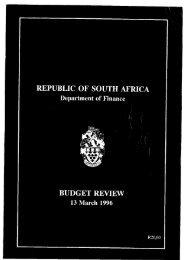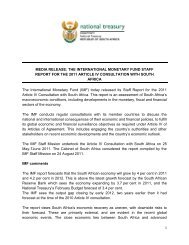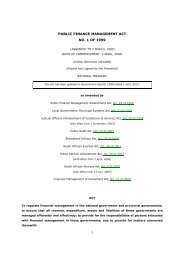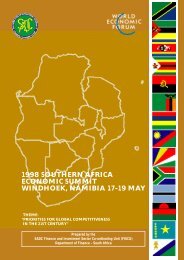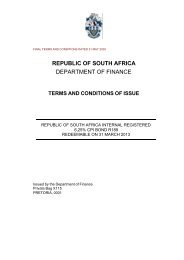Annual Performance Plan Jaarlikse ... - National Treasury
Annual Performance Plan Jaarlikse ... - National Treasury
Annual Performance Plan Jaarlikse ... - National Treasury
Create successful ePaper yourself
Turn your PDF publications into a flip-book with our unique Google optimized e-Paper software.
The provision of learnerships, apprenticeships, internships and skills programmes that are linked to work opportunities<br />
needs to be increased as follows -<br />
• Increase the number of learnerships offered in areas identified by the MEDS<br />
• Improve throughput and completion rates by offering skills-based and needs driven programmes.<br />
• Apply placement instruments (Placement instruments are used to ensure learners are correctly placed when<br />
registering for an ABET course).<br />
The WCED will also –<br />
• Investigate the establishment of a full-time ABET centre based on the outcome of the feasibility study.<br />
• Ensure improved governance of ABET centres through the implementation of relevant capacity building<br />
interventions.<br />
Progress analysis<br />
In 2002 10 000 adult learners were enrolled on ABET courses and 16 000 on Grade 10 and 12 programmes. The retention<br />
rate and throughput rate in both basic and further education at adult centres (CLCs) is poor and the province aims to change<br />
this through offering more appropriate programmes and through improved delivery mechanisms.<br />
This will be done by providing a skills-based (not school-based) ABET level 1 – 4 curriculum, which provides regular<br />
opportunities for assessment. This means:<br />
An ABET level 1 and 2 curriculum – consisting of numeracy and literacy and skills programmes<br />
An ABET level 3 and 4 curriculum – consisting of the fundamentals, and introducing core learning areas in line with the<br />
learner/centre’s direction of study in level 4 ABET<br />
Provision has been made for 2 500 new learners per annum to access ABET. “New learners” are defined as learners who<br />
enter the system for the first time and those who enter the system after a break of one year. Separate statistics will be kept to<br />
facilitate an analysis of dropouts.<br />
Learnerships, apprenticeships, internships and skills programmes focus on workplace and experiential learning. Learners<br />
tend to be drawn from the unemployed (pre-employed and retrenched) and employed, including the self-employed, and they<br />
vary in age and have quite different curriculum support needs. Successful learners achieve nationally recognized learning<br />
credits / qualifications. Learnership provision is a contractual partnership of the provider, the workplace and the learner. The<br />
Department of Labour with the SETAs is the nationally designated champion of this system of workplace provision. Except<br />
for internships, which are the experiential learning component required for some degree / diploma courses at higher<br />
education level, these learning programmes tend to be offered from ABET / NQF level 1 to NQF level 5.<br />
Analysis of constraints and measures planned to overcome them<br />
The majority of learners achieve the requested credits over a period of time of at least two to three years. Once a learner<br />
obtains the requested 120 credits required, a GETC can be issued by UMALUSI. Consequently the numbers of GETCs<br />
issued (actual performance) is relatively low compared to the target set. Furthermore, learning area certificates were issued<br />
when learners successfully completed a learning area.<br />
Intermediate and high skill development in learnerships and other learning programmes experience a number of generic<br />
problems and their resolution must be prioritised through a coordinating mechanism. Some of these problems are: poor<br />
mathematics, science and English language abilities (essentially the Foundations of the NQF system); motivation of learners;<br />
equity and scarce skills development; the fragmentation of education and training supply; and, expansion of numbers of<br />
learners in all types of provision<br />
In order to improve the quality of provision of adult education appropriate models for teaching and curriculum management at<br />
CLCs, the findings of the feasibility study will serve as a basis for any intervention. In addition, a training and development<br />
model for staff at ABET centres will be established and implemented. The model will ensure that all existing educators<br />
receive targeted training and all new educators receive orientation and training and development.<br />
<strong>Annual</strong> <strong>Performance</strong> <strong>Plan</strong> 2007/08 – 2009/10<br />
66



